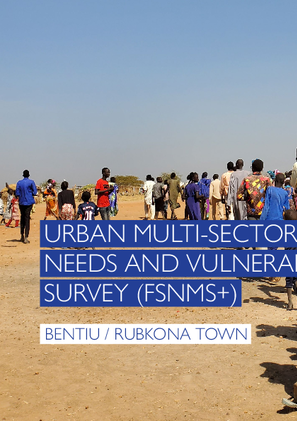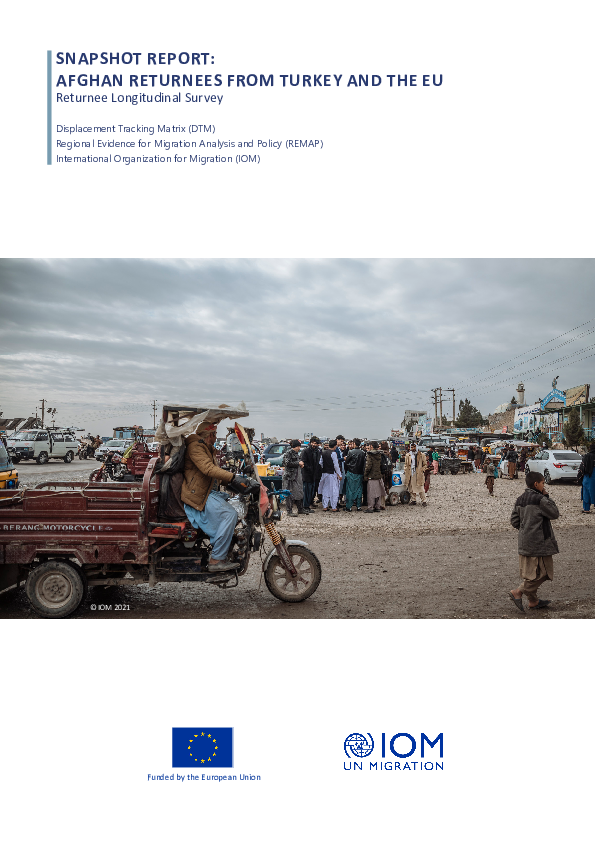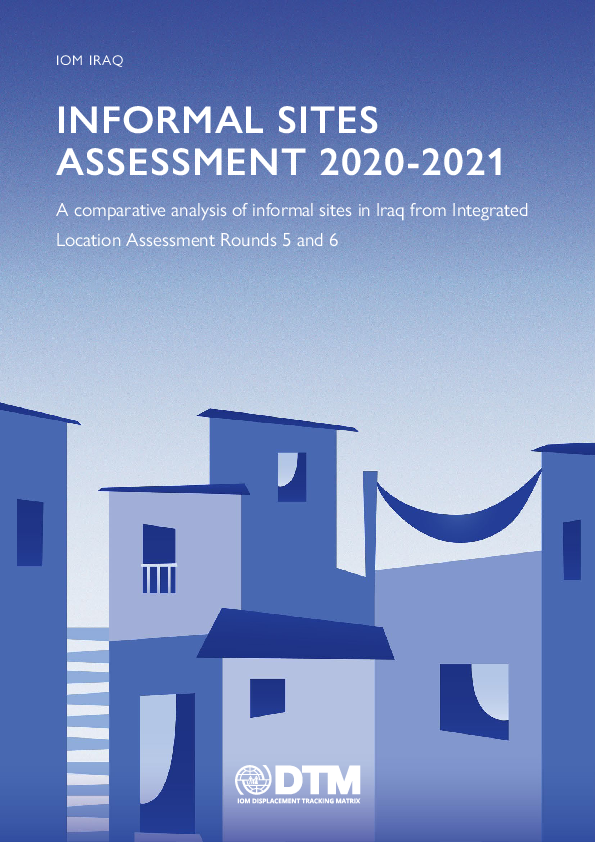-
Countries
-
Data and Analysis
-
Special Focus
-
Crisis Responses
Return Intention

Contact
DTM South Sudan, SouthSudanDTM@iom.int
Language
English
Location
South Sudan
Period Covered
Oct 12 2021
Oct 21 2021
Activity
- Survey
- Return Intention
Between September and November 2021, the International Organization for Migration’s Displacement Tracking Matrix (IOM DTM) undertook its second household-level multi-sector assessment of selected urban areas and camps for internally displaced persons (IDPs) in South Sudan. The assessment aims to:
- Quantify the prevalence of vulnerabilities and humanitarian needs across sectors, with a focus on food security, economic vulnerability and nutrition as well as selected indicators on shelter and non-food items (SNFI), education, health, water, hygiene and sanitation (WASH), protection (including child protection and gender-based violence) and mental health and psycho-social support (MHPSS).
- Generate a better understanding of urban displacement and migration, including return and relocation after displacement in South Sudan or abroad.
This survey is part of the country-wide extended Food Security and Nutrition Monitoring System (FSNMS+) assessment in South Sudan, jointly conducted by IOM, the World Food Programme (WFP), the United Nations Children’s Fund (UNICEF), the Food and Agriculture Organization (FAO), the United Nations Office for the Coordination of Humanitarian Affairs (OCHA), REACH and several humanitarian clusters. It was designed to be an independent, crisis-wide and coordinated inter-agency multi-sectoral needs assessment, mandated by the Humanitarian Country Team and endorsed by the Inter- Cluster Coordination Group. Together, the joint findings provide an evidence-base for the Integrated Food Security Phase Classification, the Humanitarian Needs Overview and the Humanitarian Response Plan.
This report presents sectoral findings for the urban area of Bentiu / Rubkona.
Separate profiles have been published for the urban areas of Juba, Wau, Bor, Yei and Malakal.
Further profiles will be published for Juba IDP Camps I and III, Naivasha IDP Camp, Bentiu IDP Camp and Malakal Protection of Civilians (PoC) Site.

Contact
DTM South Sudan, SouthSudanDTM@iom.int
Language
English
Location
South Sudan
Period Covered
Sep 24 2021
Nov 01 2021
Activity
- Survey
- Return Intention
Between September and November 2021, the International Organization for Migration’s Displacement Tracking Matrix (IOM DTM) undertook its second household-level multi-sector assessment of selected urban areas and camps for internally displaced persons (IDPs) in South Sudan. The assessment aims to:
- Quantify the prevalence of vulnerabilities and humanitarian needs across sectors, with a focus on food security, economic vulnerability and nutrition as well as selected indicators on shelter and non-food items (SNFI), education, health, water, hygiene and sanitation (WASH), protection (including child protection and gender-based violence) and mental health and psycho-social support (MHPSS).
- Generate a better understanding of urban displacement and migration, including return and relocation after displacement in South Sudan or abroad.
This survey is part of the country-wide extended Food Security and Nutrition Monitoring System (FSNMS+) assessment in South Sudan, jointly conducted by IOM, the World Food Programme (WFP), the United Nations Children’s Fund (UNICEF), the Food and Agriculture Organization (FAO), the United Nations Office for the Coordination of Humanitarian Affairs (OCHA), REACH and several humanitarian clusters. It was designed to be an independent, crisis-wide and coordinated inter-agency multi-sectoral needs assessment, mandated by the Humanitarian Country Team and endorsed by the Inter- Cluster Coordination Group. Together, the joint findings provide an evidence-base for the Integrated Food Security Phase Classification, the Humanitarian Needs Overview and the Humanitarian Response Plan.
This report presents sectoral findings for the urban area of Bor.
Separate profiles have been published for the urban areas of Juba, Wau, Yei, Bentiu / Rubkona and Malakal.
Further profiles will be published for Juba IDP Camps I and III, Naivasha IDP Camp, Bentiu IDP Camp and Malakal Protection of Civilians (PoC) Site.

Contact
DTM South Sudan, SouthSudanDTM@iom.int
Language
English
Location
South Sudan
Period Covered
Sep 20 2021
Oct 23 2021
Activity
- Survey
- Return Intention
Between September and November 2021, the International Organization for Migration’s Displacement Tracking Matrix (IOM DTM) undertook its second household-level multi-sector assessment of selected urban areas and camps for internally displaced persons (IDPs) in South Sudan. The assessment aims to:
- Quantify the prevalence of vulnerabilities and humanitarian needs across sectors, with a focus on food security, economic vulnerability and nutrition as well as selected indicators on shelter and non-food items (SNFI), education, health, water, hygiene and sanitation (WASH), protection (including child protection and gender-based violence) and mental health and psycho-social support (MHPSS).
- Generate a better understanding of urban displacement and migration, including return and relocation after displacement in South Sudan or abroad.
This survey is part of the country-wide extended Food Security and Nutrition Monitoring System (FSNMS+) assessment in South Sudan, jointly conducted by IOM, the World Food Programme (WFP), the United Nations Children’s Fund (UNICEF), the Food and Agriculture Organization (FAO), the United Nations Office for the Coordination of Humanitarian Affairs (OCHA), REACH and several humanitarian clusters. It was designed to be an independent, crisis-wide and coordinated inter-agency multi-sectoral needs assessment, mandated by the Humanitarian Country Team and endorsed by the Inter- Cluster Coordination Group. Together, the joint findings provide an evidence-base for the Integrated Food Security Phase Classification, the Humanitarian Needs Overview and the Humanitarian Response Plan.
This report presents sectoral findings for the urban area of Wau.
Separate profiles have been published for the urban areas of Juba, Bor, Yei, Bentiu / Rubkona and Malakal.
Further profiles will be published for Juba IDP Camps I and III, Naivasha IDP Camp, Bentiu IDP Camp and Malakal Protection of Civilians (PoC) Site.

Contact
DTMAfghanistan@iom.int
Language
English
Location
Afghanistan
Period Covered
May 01 2021
Aug 31 2021
Activity
- Survey
- Return Intention
This report is the result of the first round of data collection that took place from May to August 2021 with Afghan migrants who returned from Turkey and the EU in 2018, 2019, 2020 and 2021 through IOM’s Assisted Voluntary Return and Reintegration (AVRR) and Stabilisation, Reintegration and Resilience (SRR) programmes. During the data collection period, 998 respondents were interviewed in person or over the phone across 102 districts in 17 provinces.
This report is divided into three main sections. The first section summarises the key findings in this report. The second section starts with a description of the methodology and includes the research method, sampling information and limitations. The third section presents the analysis of the data that was collected between May and August 2021. The analysis chapter is further subdivided into eight thematic sections. The first subsection covers the demographics and socio-economic profiles of the return migrants. This is followed by a subsection on the employment situation, occupational sector and income and debt status of the returnees (prior to migration; in Turkey or the EU and in Round 1, which took place from May to August 2021). The third subsection explores the reasons for migration. The fourth subsection examines the migration journey, including the reasons for migrating to Turkey or the EU. The following subsection dives deeper into the reasons for return and then an additional subsection goes into the challenges that returnees experience after returning to Afghanistan. Finally, the last two subsections examine prior migration experiences and re-migration intentions.

Contact
DTM Iraq, IraqDTM@iom.int
Language
English
Location
Iraq
Period Covered
Dec 01 2020
Dec 31 2021
Activity
- Survey
- Return Intention
- Mobility Tracking
- Baseline Assessment
The Return Index is a tool designed to measure the severity of condi- tions in locations of return. The Return Index is based on 16 indicators divided into two scales: Scale 1, on livelihoods and basic services, and Scale 2, centered around social cohesion and safety perceptions. A regression model is used to assess the impact of each of the indica- tors in facilitating or preventing returns. The index ranges from 0 (all essential conditions for return are met) to 100 (no essential condi- tions for return are met). Higher scores denote more severe living conditions for returnees. The scores of the severity index are grouped into three categories: low, medium and high (which also includes very high). Refer to the “Methodological Overview” for more details on the methodology.
The Returns in Iraq: 2021 Overview provides an analysis of returns across the country. The first section of this report presents an overview of returns in 2021. The second considers conditions for returnees across all governorates of return at the end of 2021 and examines the relationship between the rate of return and the severity of those conditions. The third section outlines the areas of no return and newly assessed locations recorded by IOM’s Rapid Assessment and Response Teams (RARTs), and the returnee population living in critical shelters. The final section presents a more granular analysis of the factors driving severity in subdistricts of return which are designated as ‘hotspots’, and how these factors changed between December 2020 and December 2021.

Contact
DTM Iraq, IraqDTM@iom.int
Language
English
Location
Iraq
Period Covered
Mar 01 2018
Dec 31 2019
Activity
- Survey
- Return Intention
- Mobility Tracking
- Baseline Assessment
Nearly two years after the official end of the conflict with the Islamic State of Iraq and the Levant (ISIL), more than 4.5 million internally displaced persons (IDPs) have returned to their places of origin across eight governorates in Iraq. The Return Index measures the severity of physical and social conditions in the locations to which they are returning. This third Thematic Series report focuses on the dynamics and drivers of re-displacement, a type of secondary displacement referring specifically to “IDPs who return to their areas of origin but are unable to achieve sustainable solutions and are consequently displaced again to their first place of displacement or to a new location of displacement.” Despite some gradual improvements of conditions in return areas in Iraq, if local conditions in origin remain severe for a long period of time or undergo a sudden deterioration, returns may not be sustainable. It is in these contexts that returnee families may face pressures to leave again – in other words, they may re-displace. This report explores which push factors play a role, and to what degree, in making a location more likely to have families re-displacing, through correlating the data on locations with secondary displacement with Return Index indicators on the locations’ physical and social conditions.

Contact
DTM Iraq, IraqDTM@iom.int
Language
English
Location
Iraq
Period Covered
Apr 01 2020
Apr 30 2020
Activity
- Survey
- Return Intention
- Mobility Tracking
- Baseline Assessment
The Return Index Governorate Profiling provides singular analysis and insights on returns at the governorate level, with a comparison of figures and severity of living conditions over the course of 2019.
This report focuses on return dynamics in Ninewa Governorate, the governorate with the highest number of returnees. The report features an evaluation of conditions of return across the governorate at the end of 2019, provides insights on the mass arrivals which took place in September 2019 due to camp closures, and analyses the drivers of severe conditions across geographical hotspots that received an influx of new arrivals during that period.
KEY FINDINGS
• Ninewa Governorate hosts 1.77 million returnees out of the 4.60 million returnees in Iraq (38% of the total), making it the governorate with the highest number of returnees. Ten per cent of these returnees are currently living in locations ranked as having high severity conditions, while 32 per cent are living in medium severity locations and 58 per cent in low severity locations.
• While the absolute number of returnees living in high severity locations decreased between January and August 2019, in the last four months of 2019 the trend reversed and the number began increasing again. By December 2019, the number stood at about 174,000 individuals.
• The districts of Sinjar and Telafar host the largest number of individuals who have returned to high severity conditions. In Sinjar in particular, nearly all locations with returns are categorized as high severity – no returnee was found to be living in low severity conditions.
• A little over 52,000 returnees are living in critical shelters (3% of Ninewa’s returnee population), spread across 255 locations.
The majority of these returnees are concentrated in villages around the urban centre of Mosul district.
• Given the large presence of non-camp IDPs, one out of every four locations in Ninewa Governorate hosts both IDPs and returnees, increasing the pressure on the provision of basic needs and recovery resources. Multiple locations in Mosul and Sinjar, for instance, are currently hosting more IDPs than returnees.
• Between September and December 2019, DTM tracked almost 49,000 individuals who left camps for non-camp settings in Ninewa Governorate due to camp closures. Most of them (85%) returned to their districts of origin, while the remaining 15 per cent moved to new locations of displacement, thus becoming non-camp IDPs. The districts of Al-Ba’aj and Hatra host two thirds of these new arrivals.
• A little more than 40 per cent of the camp departures to non-camp locations in Ninewa Governorate have currently settled in locations classified as high severity. This influx points to a likely critical situation for these newly arrived households, from displacement camps to relatively deprived areas.

Contact
DTM Iraq, IraqDTM@iom.int
Language
English
Location
Iraq
Period Covered
Jul 01 2020
Jul 31 2020
Activity
- Survey
- Return Intention
- Mobility Tracking
- Baseline Assessment
The Return Index Governorate Profiling provides singular analysis and insights at the governorate level, with a comparison of figures and severity of living conditions over the course of 2019 and early 2020.
This report focuses on return dynamics in Salah al-Din Governorate, the governorate with the third largest number of returnees. The report features an evaluation of severity conditions in areas of return across the governorate in early 2020, provides insights on new arrivals due to camp closures between September 2019 and February 2020, and analyses drivers of severity across geographical hotspots in the governorate.

Contact
DTM Iraq, IraqDTM@iom.int
Language
English
Location
Iraq
Period Covered
May 01 2021
Jul 31 2021
Activity
- Survey
- Return Intention
- Mobility Tracking
- Baseline Assessment
As of July 2021, ILA 6 recorded a total of 418 informal sites. IDP families were present in 389 informal sites and returnee families were present in 31 sites. Dahuk Governorate contains 38 per cent of the informal sites nationwide (160), with Ninewa and Salah al-Din accounting for a further 18 per cent and 12 per cent, respectively (76 and 52 sites). Overall, 13,533 families were recorded as residing in informal sites in ILA6 (12,490 IDP families and 1,043 returnee families). The largest share of this population is in Anbar Governorate (28%), followed by Dahuk (24%) and Salah al-Din (14%). Between ILA 5 and ILA 6, the number of families residing in informal sites decreased by four per cent, from 14,067 to 13,533. In the same period, the number of informal sites decreased by 15 per cent , from 490 to 418 sites. The number of informal sites fell significantly in Dahuk Governorate, where there were 41 fewer sites in recorded in ILA 6. This decline is attributed to returns, predominantly to Sinjar district in Ninewa Governorate, as well as families entering camps to receive assistance, and families moving to non-critical shelters which, in a limited number of cases, was their rehabilitated residence of origin. Other governorates where the number of informal sites declined included Salah al-Din which recorded 25 fewer sites, and Kirkuk Governorate, with 19 fewer sites. Baghdad Governorate, however, recorded 11 new informal sites in ILA 6, with eight of these located in the district of Mahmoudiya.

Contact
DTM Iraq, IraqDTM@iom.int
Language
English
Location
Iraq
Period Covered
May 01 2021
Jul 31 2021
Activity
- Survey
- Return Intention
- Mobility Tracking
- Baseline Assessment
Since January 2014, Iraq’s war against the Islamic State of Iraq and the Levant (ISIL) has caused the displacement of over 6 million Iraqis – around 15 per cent of the entire population of the country. Displaced communities began to return in waves from March 2015, following the military campaigns to retake areas under ISIL control and driven by expectations of restored stability, which peaked between June 2017 and June 2018 when nearly 4 million individuals returned to their location of origin, and since then the rate of return has slowed considerably. As of July 2021, around 4.9 million returns have been recorded across 2,162 locations in Iraq, but 287 locations nationwide have not yet witnessed returns. Around 1.2 million individuals remain in displacement, including those enduring secondary displacement and/or failed returns, mostly because of ongoing safety and
security issues at the area of origin.
The Integrated Location Assessment (ILA) is an annual assessment that collects detailed information through key informants on displaced and returnee households living in locations identified through the Displacement Tracking Matrix (DTM) Master Lists. The reference unit of the assessment is the location, which is defined as an area that corresponds with either a village for rural areas or a neighbourhood for urban areas (i.e. fourth official administrative division). Routinely collected information includes geographic distribution and main characteristics of internally displaced persons (IDPs) and returnees, mobility and future intentions including obstacles to return and/or reasons to stay/return, living conditions and main needs, state of infrastructure and
services, security incidents, feelings of safety, social cohesion and reconciliation issues, and specific protection and risk indicators. The ILA VI was conducted in May–July 2021 and covered 3,757 locations, reaching 4,876,170 returnee individuals
and 1,154,462 IDP individuals (representing 99% of all recorded returnees and 97% of IDPs).
Pagination
- Previous page
- Page 17
- Next page
